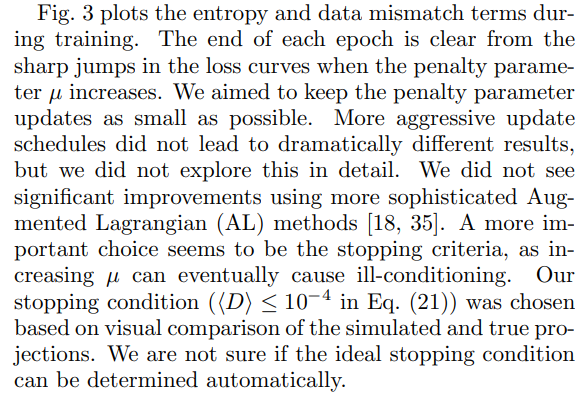Table of Links
I. Introduction
II. Maximum Entropy Tomography
- A. Ment
- B. Ment-Flow
III. Numerical Experiments
- A. 2D reconstructions from 1D projections
- B. 6D reconstructions from 1D projections
IV. Conclusion and Extensions
V. Acknowledgments and References
A. 2D reconstructions from 1D projections
Our first experiment tests the model performance in 2:1 phase space tomography. We assume an accelerator composed of drifts and quadrupole magnets, such that a symplectic transfer matrix M approximates the dynamics. The transfer matrix can be decomposed as
is a rotation by the phase advance µ. The projection angle, and hence the reconstruction quality, depends only on the phase advance. Various constraints can limit the projection angle range, but we assume the projection angles are evenly spaced over the maximum 180-degree range.
Fig. 2 shows reconstructions from a varying number of projections, comparing MENT, MENT-Flow, and the unregularized neural network (NN). It is clear that maximizing the stochastic estimate in Eq. (16) pushes the distribution’s entropy close to its constrained maximum. (Recall that MENT maximizes entropy by construction). Although the MENT solutions are of higher quality, the differences are not visible from afar.
Fig. 2 illustrates that entropy maximization is a conservative approach to the reconstruction problem. All reconstructed features are implied by the data. In contrast, the distributions in the bottom rows fit the data but are unnecessarily complex. Of course, reconstructions from one or two projections are bound to fail if the prior is uninformative, but these cases are still useful because they demonstrate MENT’s logical consistency: given only the marginal distributions and an uncorrelated prior, the posterior is the product of the marginals. On the other extreme, with enough data, the feasible distributions differ only in minor details. MENT shines in intermediate cases where the measurements contain just enough information to constrain the distribution’s primary features. For example, the continuous spiral structure develops rapidly with the number of views in Fig. 2.
Fig. 2 also illustrates the flow’s capacity to represent complicated distributions despite the restriction to invertible transformations. This example focuses on spiral patterns, which are characteristic of nonlinear dynamics. (Additional examples are included in the supplemental material.) It is important to note that, while our analysis focuses on the beam core, low-density regions can also impact accelerator performance [33]. Flows can struggle to model distribution tails [34]. Our ground-truth distribution does not have significant halo and we do not report the agreement at this level; however, preliminary studies indicate the Kullback-Leibler (KL) divergence may enhance dynamic range relative to, i.e., the mean absolute error when fitting data.

:::info
Authors:
(1) Austin Hoover, Oak Ridge National Laboratory, Oak Ridge, Tennessee 37830, USA ([email protected]);
(2) Jonathan C. Wong, Institute of Modern Physics, Chinese Academy of Sciences, Lanzhou 730000, China.
:::
:::info
This paper is available on arxiv under CC BY 4.0 DEED license.
:::











